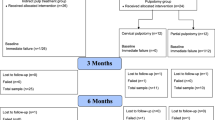Abstract
AIMS: These were to examine the main presenting, treatment and outcome factors for intruded permanent incisors in children, the effect of apical development and degree of intrusion on decisions on repositioning, the effect of apical development status on the maintenance of pulp vitality and the time of pulp extirpation and to compare the decisions made to the advice given in existing clinical guidelines. METHODS: A sample of 55 intruded incisor teeth in 40 children aged between 6 and 14 years of age was reviewed in respect of management of their intrusive dental injuries. Of these teeth 17 were intruded in females and 38 in males. Mean (±SD) age was 9.3 (±1.99) and mean follow-up time was 2.3 years (±1.60). Included in the sample were 42 maxillary central incisors and 13 maxillary lateral incisors. RESULTS: Immature apicies were noted in 34 whilst 21 teeth had mature apices. Clinical and radiographic assessment categorised 4 teeth as mildly intruded with displacement of less than 3 mms; 10 teeth, intruded by 3–6 mm, were considered as moderately intruded whilst a further 11 teeth with intrusion of more than 6mm were considered to have experienced a severe intrusive injury. There were 19 teeth (35%) that were allowed to re-erupt spontaneously, 22 (40%) were repositioned by orthodontic means and 14 teeth (25%) received surgical repositioning. CONCLUSION: There was a statistically significant difference between the repositioning decisions with a more conservative approach for teeth with immature apices (P = 0.0009). Apical completion was a significant predictor of earlier pulp extirpation (p=0.01).
Similar content being viewed by others
References
Al-Baldri S, Kinirons M, Cole B, Welbury R. Factors affecting resorption in traumatically intruded permanent incisors in children. Dent Traumatol 2002;18(2): 73–76.
American Academy of Pediatric Dentistry(AAPD) Guideline on Management of Acute Dental Trauma; Reference Manual 2007; V29 No. 7, 07/08.
Andersson L, Bodin I, Sorenson S. Prognosis of root resorption following replantation of human teeth after extended extra-oral storage. Endod Dent Traumatol 1989; 5: 33–47.
Andreasen FM, Pedersen BV. Prognosis of luxated permanent teeth—the development of pulp necrosis. Endod Dent Traumatol 1985; 1(6): 207–20.
Andreasen JO, Andreasen FM, Bakland LK, Flores MT. Traumatic Dental Injuries: A Manual, 2nd edn. Copenhagen: Blackwell Munksgaard Publishers; 2003.
Andreasen JO, Bakland LK, Matras RC, Andreasen FM. Traumatic intrusion of permanent teeth. Part 1. An epidemiological study of 216 intruded permanent teeth. Dent Traumatol 2006a; 22(2): 83–89.
Andreasen JO, Bakland LK, Andreasen FM. Traumatic intrusion of permanent teeth. Part 2. A clinical study of the effect of pre-injury and injury factors, such as sex, age, stage of root development, tooth location, and extent of injury including number of intruded teeth on 140 intruded permanent teeth. Dent Traumatol 2006b; 22(2): 90–98.
Andreasen JO, Bakland LK, Andreasen FM. Traumatic intrusion of permanent teeth. Part 3. A clinical study of the effect of treatment variables such as treatment delay, method of repositioning, type of splint, length of splinting and antibiotics on 140 teeth. Dent Traumatol 2006c; 22(2): 99–111.
Andreasen JO, Vinding TR, Christensen SS. Predictors For Pulp Healing Complications In The Permanent Dentition After Dental Trauma. Endodontic Topics 2006d; 14, 20–27.
Chaushu S, Shapira J, Heling I, Becker A. Emergency orthodontic treatment after the traumatic intrusive luxation of maxillary incisors. American J of Orthodontics and Dentofacial Orthopedics 2004; 126(2): 162–172.
Ebeleseder KA, Santler G, Glockner K, Hulla H, Pertl C, Quehen Berger F; An analysis of 58 traumatically intruded and surgically extruded teeth. Endod Dent Traumatol. 2000; 16(1): 34–39.
Flores MT, Andersson L, Andreasen JO, Bakland LK, Malmgren B, Barnett F, Bourguignon C, Di Angelis T, Hicks L, Sigurdsson A, Trope M, Tsukiboshi M, von Arx T. Guidelines for the management of traumatic dental injuries. 1. Fractures and luxations of permanent teeth. Dent Traumatol. 2007; 23(2): 66–71.
Jacobsen I. Clinical follow-up study of permanent incisors with intrusive luxation after acute trauma. J Dental Research 1983; 62: 486. Abstract no. 37.
Humphrey JM, Kenny DJ, Barrett EJ. Clinical outcomes for permanent incisor luxations in a pediatric population. I. Intrusions. Dent Traumatol 2003; 19: 266–273.
Kenny D, Barrett E, Casas M; Avulsions and intrusions: The controversial displacement injuries. J Can Dent Assoc 2003; 69(5): 308–13.
Kinirons MJ. UK National Clinical Guidelines in Paediatric Dentistry. Treatment of traumatically intruded permanent incisor teeth in children. Int J Paediatr Dent 1998; 1–3.
Kinirons MJ, Sutcliffe J. Traumatically intruded permanent incisors: a study of treatment and outcome. Br Dent J 1991; 170: 144–6.
Saroglu I, Tunc ES, Sönmez H. Spontaneous re-eruption of intruded permanent incisors: five case reports. Oral Surg Oral Med Oral Pathol Oral Radiol Endod. 2006 Oct; 102(4): e60–5. Epub 2006 Jul 17.
Wright G, Bell A, Mc Glashan G, Vincent C, Welbury RR. Dentoalveolar trauma in Glasgow: an audit of mechanism and injury. Dental Traumatol 2007; 23(4): 226–231.
Author information
Authors and Affiliations
Corresponding author
Rights and permissions
About this article
Cite this article
Stewart, C., Dawson, M., Phillips, J. et al. A study of the management of 55 traumatically intruded permanent incisor teeth in children. Eur Arch Paediatr Dent 10, 25–28 (2009). https://doi.org/10.1007/BF03262663
Published:
Issue Date:
DOI: https://doi.org/10.1007/BF03262663




